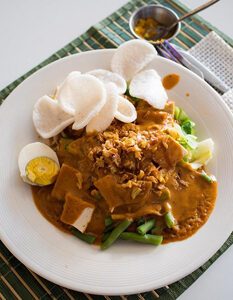By Sharon Hudgins
Recently, as the Covid-19 pandemic has spread and we’ve been asked to follow strict “stay-at-home” directives, I’ve been thinking about other times in my life when I’ve been isolated in a house or apartment building with other people, sometimes voluntarily, sometimes unwillingly but of necessity. And I remembered how cooking and sharing meals together was one of the best ways we kept “cabin fever” at bay (most of the time, anyway). Those long-ago experiences were good training for what all of us are going through today.
My first experience of enforced isolation happened in my early 20s, when I was a graduate student traveling alone around the British Isles on my first trip to Europe. On the last day of that journey, I was staying at a bed-and-breakfast on a sheep farm in England when a horse-riding accident injured my back and legs so badly that I couldn’t travel for another month, until I was able to walk again.
But there was a silver lining to that dark cloud. The 400-year-old farmhouse was a picturesque place to convalesce, and the couple who owned it were kind enough to take good care of me, even though I must have been a burden to their daily routine. The wife was a very good cook, and I looked forward to every meal there—meals made with fresh vegetables from the garden and fresh meats from their farm animals, all cooked on a big, old, coke-burning stove. She also loaned me the cookbook she’d used for 25 years (the first British cookbook I’d ever seen), which I read cover-to-cover while sitting in front of the fire blazing in the open fireplace in their living room. And when I was well enough to scoot around the house on my still-stiff legs, she let me watch her prepare foods in the kitchen and shared many of her favorite personal recipes with me, too.
Cooking, kindness, and comfort food got me through that first real health crisis in my life—and became a lesson for coping with other challenges in the decades that followed.
My next isolation experience was just two years later, when my new husband and I moved from where we were living in Germany to a remote village in the Scottish Highlands. The only place we could find to rent was on the far north coast of Scotland: a tiny (370-square-foot) two-room stone cottage, built in the 1820s. Recently a small wooden shed had been attached to the back, housing a basic kitchen and bathroom and adding another 150 square feet to the place. The oven in the kitchen’s little electric stove never worked properly, so we ended up baking all our breads, cakes, and cookies in the big Victorian-era fireplace in the living room. Summer, fall, and winter, we always had a fire in that fireplace, the only heating for the cottage. But in the winter, the bathroom in the little attached shed was so cold that our toothpaste froze solid.

Postcard (circa 1950) of the remodeled cottage in the Scottish Highlands where the author lived, many years later.
Despite those discomforts, we came to love living in that old cottage, even though there was nothing much “to do” in that part of the world. No telephone. No TV. No cinemas. And in our village of only 250 people, the only two places to “eat out” were a small hotel pub and an old hunting-lodge hotel (not even open in winter). On our tight budget, we couldn’t afford to eat out anyway. So cooking three meals a day became a big focus of our life there. We enjoyed making dishes from recipes we’d brought from Germany and trying out new recipes from the few cookbooks we’d toted along, too (although our attempt at making French baguettes was a flop!). Many of those recipes are still in our repertoire of favorites today.

Back view of the author’s cottage in Scotland, showing the kitchen/bathroom shed. [Credit: (c) Sharon Hudgins]
Fast-forward to Siberia in the early 1990s, when we voluntarily moved from our home in Germany to work as university professors in Russia, shortly after the collapse of the Soviet Union. We arrived just in time for an economic depression that makes this year’s stock market crash look like a minor blip on a chart. Living in two different cities, in ugly Soviet-style high-rise apartment buildings, we had to contend with erratic electricity and heating, as well as polluted water from our taps, which had to be boiled and filtered before use (in one city, the water supply was contaminated with cholera bacteria). Just like in Scotland years before, there were no modern supermarkets, very few places to eat out, no phone, no TV, few outside sources of news, no Internet. And we didn’t have a car for going grocery shopping.
Shopping for food was a daily chore after work and on weekends, as we scoured sparsely stocked food stores and better-supplied farmers’ markets for whatever products might be available that day, even that hour. Eggs disappeared from the shelves for a couple of weeks at a time. Sugar couldn’t be found anywhere for two months. Flour, sold out of wooden barrels and weighed on an old-fashioned scale, was often so adulterated with impurities that we had to sift them out before using it. Over the year and a half that we were in Russia, life began to improve a bit, but never reached the level of material variety and abundance that people took for granted in the West.Despite those difficulties, cooking at home every day became a coping strategy again, especially during the dark Siberian winters when we were cooped up in our apartment for days at a time. We enjoyed making meals from whatever ingredients happened to be available—even cold meals when we had no electricity for cooking. We experimented with new recipes from friends and cookbooks. We made tried-and-true dishes from recipes we’d brought with us from Europe and the U.S., including big pots of fiery Texas chili. And we gave informal dinner parties with friends and colleagues to help everyone make it through hard times. Thank goodness we didn’t have to deal with a global pandemic, too.
After those experiences, I chuckle at people in America today who are upset about not being able to eat at their favorite fast-food joint. Or who are hoarding six months’ supply of toilet paper. Or complaining that a store is temporarily out of their preferred brand of breakfast cereal. But I’m not being critical. Like so many of my fellow Americans, I feel the pain, too. I’ve lost some of the contract jobs I was counting on this year. All my travel plans have been canceled. And by now—given the “six degrees of separation” between any of us—most of us know at least one other person who has contracted this terrible virus. Yes, 2020 is a much different place than it was just a few months ago.
We’re all in the same boat now, stuck at home by necessity, not choice—many of us confined to a limited space along with bored kids, cranky spouses, and insistent pets, all of whom want (and need) to be fed. That’s when comfort foods can help us keep calm in this crisis, especially when faced with forces beyond our control. We can be in control in our kitchens.
My husband and I have been trying out new recipes from cookbooks that we didn’t have time to read before. We’ve been gleaning unusual recipes from trusted sources online, such as recipes for making for Israeli shakshuka and Mexican chipotle rice with shrimp and cilantro. And we’ve been reviving recipes from my Stars and Stripes newspaper columns back in the 1980s and Chile Pepper magazine in the 1990s, which we haven’t made for years: spicy Indonesian gado-gado, Austrian Kaiserschmarrn, Spanish almond Tarta de Santiago.
In the spirit of sharing recipes for comfort foods, to keep us all from going stir crazy right now, here is my recipe for Indonesian gado-gado (mixed vegetables with spicy peanut sauce). You probably already have most of the basic ingredients in your pantry and fridge—unless you stocked up on too much toilet paper when the pandemic hit and now don’t have space for food in your house.
Finally, full disclosure: I have to admit that while writing this article, I couldn’t resist eating a big square of Moser Roth chile-chocolate from Germany, even on a too-warm spring day in Texas. Instant comfort food at its finest! Who doesn’t turn to chocolate at a time of stress?
Recipes:
Indonesian Gado-Gado (Mixed Vegetables with Spicy Peanut Sauce)
Gado-gado is a classic Indonesian dish, an excellent main-dish salad for hot summer days. It’s a colorful medley of vegetables (raw, boiled, steamed, fried), hard-boiled eggs, and often other ingredients, too (fried tofu, omelet strips, crisp-fried onions, and shrimp chips), all served with a spicy peanut sauce. You can make it up to 3 days in advance and refrigerate until needed. Let the ingredients come to room temperature before serving, but warm up the sauce so it can be spooned over the vegetables. (If you don’t have all the vegetables listed in this recipe, just mix-and-match with whatever you have on hand. It’s also good way to use up leftover cooked vegetables.)
NOTE: If you are planning to eat the gado-gado right away, make the Peanut Sauce first (recipe follows). If you want to use the additional suggested ingredients described at the end of this recipe, also make these first and set aside.
3 medium (or six small) boiling potatoes, peeled and quartered (if large, cut into eighths)
3 medium carrots, peeled and julienned (cut into matchstick-size pieces, about 4 inches long)
1 pound fresh green beans, sliced diagonally into bite-size pieces
1/2 green or white cabbage, cored and thinly sliced
1 medium onion, cut lengthwise into thick slices
1 pound fresh bean sprouts
1 medium cucumber, unpeeled, thinly sliced crosswise
2 fresh hot green chile peppers, sliced crosswise into thin rounds
3 hard-boiled eggs, quartered
3 limes, quartered
Steam the potatoes over boiling water for 20 minutes. Set aside to cool. Steam the carrots, green beans, cabbage, and onion each for 8 to 10 minutes—or together in separate piles if you have a large steamer. (If you have a large 2-part steamer, you can steam the potatoes in the bottom tray for 10 minutes, then add the second steamer tray—containing the carrots, green beans, cabbage, and onion—on top. Cover and steam all the vegetables for 8 to 10 minutes more.)
While the vegetables are steaming, blanch the bean sprouts. Pour boiling water over them in a large bowl, let them sit for 1 to 2 minutes, then drain in a colander and refresh under cold running water. Drain thoroughly.
Attractively arrange all the steamed vegetables, bean sprouts, raw vegetables, hard-boiled eggs, and lime wedges on 2 or 3 large serving platters. Sprinkle (optional) Crisp-Fried Onion Flakes over the top as a garnish. Serve the Peanut Sauce in a separate bowl. Place the (optional) Shrimp Chips in a serving basket.
Serve cool or at room temperature. Let each person take a portion of the vegetables and other ingredients from the platters. Squeeze fresh lime juice over the ingredients on your plate, and spoon Peanut Sauce (hot, warm, or room temperature) over all. Eat the Shrimp Chips as an accompaniment. Cold beer goes well with this meal.
Makes 6 servings.
Sauus Kacang (Spicy Peanut Sauce)
1 tablespoon peanut oil
1 small onion, finely chopped
4 large garlic cloves, minced
1 tablespoon grated fresh ginger
1-2/3 cups water
1/4 cup fresh lime or lemon juice
1 tablespoon soy sauce
1 tablespoon dark brown sugar
1-1/2 to 2 teaspoons sambal oelek (Indonesian crushed hot chile paste), or crushed dried hot chile flakes
1 teaspoon sesame oil
1/4 teaspoon ground cumin
1-1/4 cups chunky natural peanut butter (100% peanuts, not hydrogenated)*
* Or make your own chunky peanut butter from 2 cups of roasted peanuts and 1-1/2 tablespoons of peanut oil, processed in 2 batches, in a food processor until almost smooth.
Heat the peanut oil in a medium saucepan over medium heat. Add the onion and sauté, stirring frequently, until golden (about 5 minutes). Add the garlic and ginger and sauté 1 minute longer. Stir in the water, lime or lemon juice, soy sauce, brown sugar, sambal or dried chile flakes, sesame oil, and cumin.
Bring the mixture to a boil over medium heat, then whisk in the peanut butter. Cook over medium heat, stirring constantly, until the sauce is thickened (3 to 5 minutes). Taste and add salt if necessary. (If the sauce seems too thick, thin it down with a bit of coconut milk or water, but don’t dilute it too much.)
Serve warm, spooned over the prepared gado-gado ingredients.
Makes approximately 3 cups.
ADDITIONAL SUGGESTED INGREDIENTS
► Goreng Bawang (Crisp-Fried Onion Flakes): Slice a large onion crosswise into very thin rounds, cut them into quarters, and separate all the pieces. Heat 1 cup peanut or corn oil in a medium skillet over medium heat. When oil is very hot, fry the onions in it, stirring constantly. When onions turn golden, reduce heat to very low and cook, stirring frequently, to brown them evenly without burning. Total time for cooking onions: about 30 minutes. When the onions are a rich brown color, pour them into a large sieve and drain thoroughly. When completely cool, store in an airtight container. (Keep the oil, which has a nice onion aroma and can be used again for frying.) To serve, sprinkle the fried onion flakes liberally over the cooked vegetables. Makes enough onion flakes to garnish 6 servings of gado-gado. Recipe can be doubled.
► Dadar Telur (Omelet Strips): Lightly whisk together 3 eggs, 2 finely chopped green onions (white and green parts), and 1/2 teaspoon salt. Heat 2 tablespoons peanut oil in a medium skillet over medium-high heat. When the oil is very hot, pour the eggs into the pan and tilt it to spread them evenly over the bottom. Cook until eggs are set, then turn with a spatula to lightly brown the other side. Slide the omelet onto a plate. When cool, cut the omelet into thin strips. Serve on a platter with the other gado-gado ingredients.
► Goreng Tahu (Fried Tofu): Pat dry with paper towels 1 pound firm tofu, then cut it into 1-inch cubes. Dredge in 1/2 cup cornstarch and shake off the excess. Pour peanut oil into a skillet, deep fryer, or wok to a depth of 2 inches, and heat over medium-high heat. When oil is very hot, fry the tofu in batches, for 2 to 3 minutes each, turning the tofu once while frying, until tofu is golden. Transfer to paper towels to drain. Serve on a platter with the other gado-gado ingredients.
► Krupuk Udang (Shrimp Chips): These are little flat wafers that sold at many Asian grocery stores. Made from ground shrimp, manioc flour, egg whites, and spices, they puff up into large, lightweight “chips” (much like potato chips) when you drop them in hot oil. You can also buy commercially fried ones, already puffed up, which come in bags like potato chips.
To fry your own, using the wafers, heat at least 2 inches of peanut oil in a deep skillet or wok. Drop 1 or 2 of the wafers in the hot oil. Very quickly they will puff up to 2 or 3 times their original size. Remove with a skimmer and drain on paper towels. Repeat with the remaining wafers. Serve in a bowl as an accompaniment to gado-gado.
Sharon Hudgins is a food writer and cookbook author who has lived in 10 countries around the world. See more about her books and recipes at www.sharonhudgins.com







